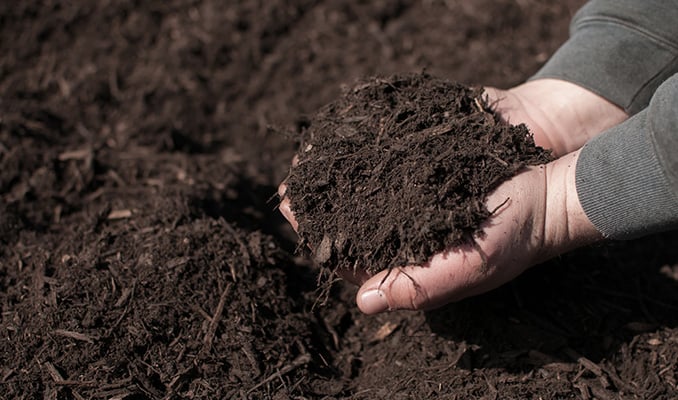What Is Mulch And Why Is It Essential For Better Yields?
Published :
Jul 19, 2018
Categories :
Other subjects

Mulch is discarded garden waste used to supercharge your cannabis with a rich source of nutrients. Acting as a protective barrier, mulch is essential for better yields in an outdoor organic growing environment.
Mulch is an essential building block for an organic growing environment. It can provide protection against diseases, while retaining nutrients for growth and keeping roots moist. With such a powerful skillset, what is mulch? And how can this natural part of an ecosystem be utilised to benefit your cannabis?
THE POWER OF MULCH
Forests and similar ecosystems thrive without any outside interference. They don't fall prey to damaging diseases, nobody needs to water them, and they always have the nutrients they need to survive. If, when growing outside, we could mimic this effect in our own organic cannabis growing environments, the benefits and the reduction in workload would be substantial.
Mulch can be defined as broken down organic material that covers the soil. In forests, mulch consists of fallen or dead plant matter like leaves and small branches. It also includes dead insects and any other substances which have fallen to the floor. All of these elements cause mulch to be packed with nutrients; the very nutrients plants use to grow in the first place. Once stored in living plants, they are returned to the soil when the plants begin to decompose, thus perpetuating the natural cycle of life.
THE SCIENCE BEHIND MULCH
Plants, including cannabis, pull nutrients from the soil via their roots. These nutrients provide marijuana with the power to grow, flower, and produce bountiful buds. When your cannabis plants have been harvested and are no longer of any use, they still contain those blocks of nutrients; however, they need to be broken down before they can be of any use to other plants.
The decomposition taking place within mulch is driven by insects, microbes, bacteria, and fungi that live and flourish just under the surface. Together, they break down the nutrients contained within dead plant matter, enabling its use and absorption by other plants through the soil. As a result of this thick layer of living, nutrient-rich mulch, soil benefits in the following ways:
• Protection from the elements
• Reduction in water evaporation
• Increased supply of nutrients (specifically nitrogen)
• Insulated against hot and cold
Mulch can be split into two categories: woody (brown) mulch and fresh green mulch. Both bring specific advantages to marijuana growth.
WHY CANNABIS PLANTS THRIVE IN MULCH
WOODY MULCH
Let’s start with the first of the two types of mulch typically used, woody mulch. Comprised of shredded tree bark (or the cannabis stalks from last year’s harvest), woody mulch is a breeding ground for fungi. Don’t be alarmed though; these fungi are here to help us out. Boosting the fungi population through the application of wet, shredded bark material lowers your growing medium’s overall pH. Fungi prefer a slightly more acidic environment—something cannabis also favours in the flowering stage.
A significant “watch out” here is to avoid cedar bark and walnut mulch. The cedar bark is not a great environment for insects to live, and walnut mulch can contain toxins harmful to cannabis.

FRESH GREEN MULCH
The second mulch candidate is fresh green mulch. Consisting of lawn waste, fresh grass clippings, leaves from your previous cannabis harvest, and the younger branches left over from pruning—this mulch encourages the growth of bacteria, and is responsible for creating a more alkaline growing media. Cannabis in the vegetative stage benefits from a higher concentration of bacteria, encouraging better uptake of nutrients.
With fresh green mulch, the thing to watch out for is pesticides. Ensure the garden waste you are using has not been treated previously. Pesticides can detrimentally affect your cannabis and the safety of the buds produced at the time of harvest. Also, ensure that any weeds or other pests are not present in the green waste—both will contaminate your growing medium and drain valuable nutrients away from your cannabis.
ADDING NITROGEN
The final step in preparing your mulch. Without nitrogen, microbial life would be limited. Microlife is responsible for breaking down the bark or garden matter, thus releasing the nutrients into the soil. Adding nitrogen is achieved by using alfalfa meal or blood meal, both of which can be purchased from garden centres.
MULCH INCREASES YIELDS
A careful combination of both types of mulch achieves one integral outcome: better nutrient uptake for your cannabis during its vegetative and flowering stages. With a steady supply of the right nutrients and the correct pH, your plant's energy can instead be put toward bud development. This means bigger, more potent buds—simply through the practical use of mulch.
The mulch also acts as a barrier to harsh climates, ensuring the root system can do two things. Firstly, roots can grow closer to the surface, where nutrient concentration is at its highest. The mulch also ensures the soil remains moist, providing a better supply of water. When growing outdoors, you are at the mercy of the elements. Mulch is your natural, organic, protective barrier. Refreshing the layers of mulch throughout the lifecycle of your cannabis will ensure you provide the best possible access to valuable nutrients when growing outdoors.






































